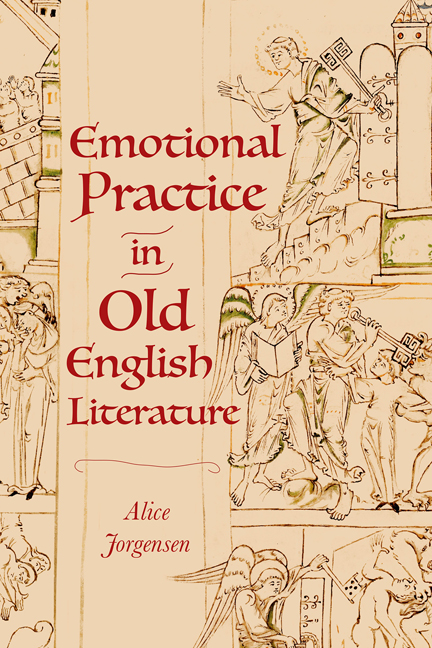Book contents
- Frontmatter
- Dedication
- Contents
- Acknowledgements
- Abbreviations
- Introduction: The Wanderer and Emotional Practice
- 1 Participating in a Heroic Emotional Style: Beowulf
- 2 Uses of the Heroic Style: The Battle of Brunanburh and The Battle of Maldon
- 3 Controlling and Converting Emotion: The Old English Boethius
- 4 Relating to the Divine in the Exeter Book: Christ I and Christ III
- 5 Performing Fear in Old English Homilies
- Conclusion
- Bibliography
- Index
- Miscellaneous Endmatter
5 - Performing Fear in Old English Homilies
Published online by Cambridge University Press: 09 May 2024
- Frontmatter
- Dedication
- Contents
- Acknowledgements
- Abbreviations
- Introduction: The Wanderer and Emotional Practice
- 1 Participating in a Heroic Emotional Style: Beowulf
- 2 Uses of the Heroic Style: The Battle of Brunanburh and The Battle of Maldon
- 3 Controlling and Converting Emotion: The Old English Boethius
- 4 Relating to the Divine in the Exeter Book: Christ I and Christ III
- 5 Performing Fear in Old English Homilies
- Conclusion
- Bibliography
- Index
- Miscellaneous Endmatter
Summary
ONE OF the major genres of Old English literature to have been preserved – by sheer bulk, the major genre – is that of homilies or sermons. There is a technical distinction between the two, a homily being an exposition of a gospel pericope and a sermon a more general exhortation, but in the surviving collections they appear alongside each other and are also intimately associated (for example, in copies of Ælfric's Catholic Homilies) with saints’ lives; in Old English studies, ‘homily’ is widely used as an inclusive term for any text for preaching. Homilies are designed, on the one hand, to teach, and, on the other, to admonish: to educate their audiences about Christian beliefs and worship, and to urge and motivate them to repentance and right action. Some of these texts are sober explanations or narratives; but some are highly coloured exhortations, and among these many present detailed accounts of the Last Days. Like the Judgement Day poem Christ III, discussed in the previous chapter, these sermons openly aim to provoke emotion, specifically fear; indeed they usually directly refer to fear – ege, egesa, fyrhtu, (on)drædan – and invite conscious thought about it.2 The present chapter examines a selection of these texts: two of the earlier anonymous homilies, Vercelli II and Blickling X, and the corpus of sermons by archbishop Wulfstan of York (his sermons being a porous category closely linked to his tracts and lawcodes). It approaches these texts as scripts for self-conscious emotional processes, which take place in a social transaction between the preacher (whether present in person or textualized as the implied speaker of a written utterance), the audience, and God.
Injunctions to fear the last days and to weep for one's sins recur through Old English homiletic prose and, indeed, eschatological poetry. The opening of Vercelli Homily IV succinctly states the core idea:
Men þa leofestan, ic eow bidde 7 eaðmodlice lære þæt ge wepen 7 forhtien on þysse medmiclan tide for eowrum synnum, for þan ne bioð eowre tearas 7 eowre hreowsunga for noht getealde on þære toweardan worulde.
- Type
- Chapter
- Information
- Emotional Practice in Old English Literature , pp. 177 - 213Publisher: Boydell & BrewerPrint publication year: 2024



